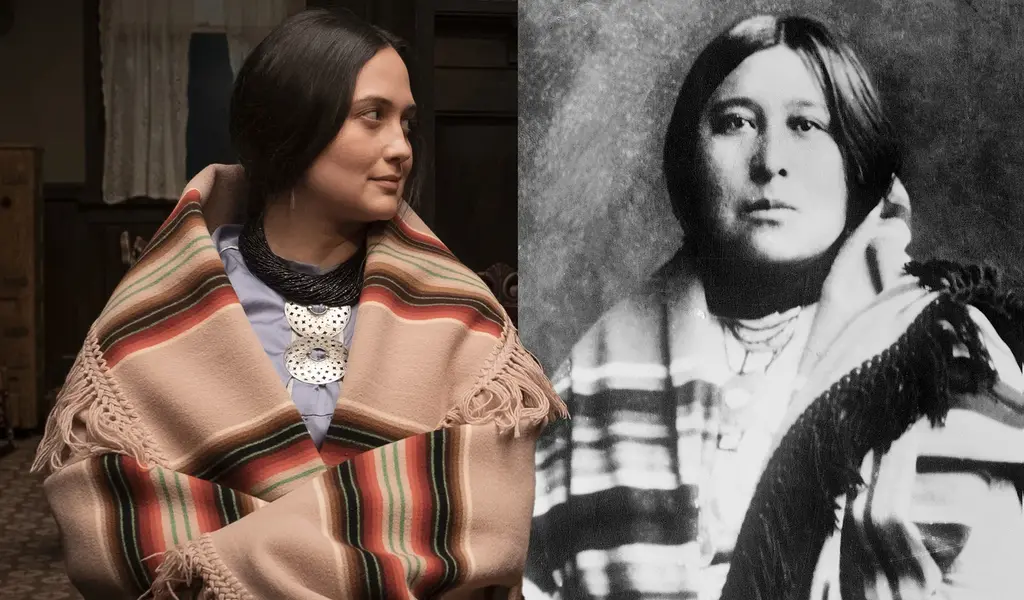(CTN NEWS) – “Killers of the Flower Moon,” directed by Martin Scorsese and starring Leonardo DiCaprio, Robert De Niro, and Lily Gladstone, delves into a haunting chapter of American history.
The film, set to release this week, is inspired by a deeply troubling true story.
The theme of forgotten or erased history, particularly concerning the injustices faced by Native American communities, has been gaining attention in recent years.
In “Killers of the Flower Moon,” the line uttered by Robert De Niro’s character, “They won’t remember,” reflects the belief that the Osage Nation’s tragic history would be forgotten.
The brutal murders of wealthy Osage people during the early 1920s were systematically concealed.
David Grann’s book, “Killers of the Flower Moon: The Osage Murders and the Birth of the FBI,” which inspired the film, helped bring this dark chapter of history back into the mainstream.
Grann notes that many readers expressed their astonishment at never having learned about these events, which reflects the underlying prejudice that led to these crimes.
This oversight in recognizing and acknowledging the injustices faced by Native Americans is part of a larger issue in US culture.
The dispossession of Native American land played a central role in the formation of American democracy.
While African American slavery is increasingly recognized as central to American history, Native American experiences have often been overlooked.
Scholars like Ned Blackhawk aim to rectify this by restoring Native American injustices to their rightful place in the narrative of American history.

At the heart of “Killers of the Flower Moon,” both in the book and film, is the character Mollie Burkhart, portrayed by Lily Gladstone.
Mollie is a modest yet oil-rich Osage woman whose family was specifically targeted during the Osage murder conspiracy.
Her sister was shot to death, another had her house firebombed, and their mother was likely poisoned. Later, Mollie herself fell mysteriously and gravely ill.
Her true story exemplifies the cultural environment that allowed the “Reign of Terror” to occur and then be brushed aside.
The dispossession of Native American land began with Columbus and continued for centuries.
In the 19th century, the US government forced the Osage people off their land in Kansas, and they subsequently moved to Oklahoma, where the discovery of oil made them incredibly wealthy, becoming the world’s richest people per capita at that time.
Despite their newfound wealth, the US government often labeled Indigenous people as “incompetent,” a designation that hinged on their Native heritage.
Guardians, frequently corrupt, were appointed to oversee and restrict how those labeled as “incompetent” could spend their own money.
The film highlights the injustice of this practice as we see Mollie meeting with a guardian, even though she is highly intelligent and capable.
The film, like the book, masterfully captures Mollie’s deeply personal narrative and the cultural prejudice that allowed these heinous crimes to transpire.
In the early 1920s, William Hale, a prominent figure in Osage County, represented a venal man who considered Native Americans as subhuman while pretending to be the tribe’s friend and benefactor.
Hale encourages his equally greedy nephew, Ernest Burkhart, a World War I veteran portrayed by Leonardo DiCaprio, to marry Mollie.
The film deliberately leaves viewers questioning whether Ernest truly loves her, is marrying for her wealth, or is driven by a combination of motives, a question that becomes increasingly significant in Mollie’s life as well.

Martin Scorsese’s film employs mock archival newsreels to illustrate the perplexed resentment of white society towards the wealthy Osage people, who were chauffeured and adorned in fashionable furs and jewels.
Mollie Burkhart, in contrast, wore a traditional blanket as a coat and lived a simple life despite her opulent house and servants.
Nevertheless, David Grann’s book references a 1920 article in Harper’s Monthly Magazine titled “Lo, the Rich Indian!” which remarks on the peculiarity of “red millionaires.”
In 1922, a travel magazine featured a typical article called “Our Plutocratic Osage Indians.” These historical documents highlight the fascination and sometimes disdain with which Osage wealth was viewed by the white population of that time.
Increased Public Awareness
Many white individuals married into the Osage tribe, often with sinister intentions.
The US government allotted parcels of Oklahoma land to the Osage, and tribe members retained the rights to profit from the oil found on their land, known as headrights.
Importantly, these headrights could only be inherited, not sold. Marrying an Osage person with headrights was a way for white individuals to gain access to the oil money.
This devious tactic involved feigning love for an Osage individual while simultaneously plotting to kill them, as depicted in Scorsese’s film.
William Hale, the film’s main antagonist, openly expresses the view that the Osage are undeserving of their wealth and, eventually, their lives.
Hale was not the sole perpetrator. “The more I dug into it, the more I realised this was really about a culture of killing and a culture of complicity,” says David Grann.
He found evidence of doctors administering poison, morticians covering up bullet wounds, and guardians, lawmen, and prosecutors who either failed to investigate these crimes or may have played a role in them.
Many others were complicit through their silence. The Reign of Terror against the Osage Nation involved a vast network of individuals, including both those who committed the murders and those who enabled them.

The film effectively portrays the real-life culture of white supremacy prevalent during that era.
It briefly alludes to the nearby Tulsa Race Massacre of 1921, which coincided with the Osage murders.
The Tulsa Race Massacre involved the destruction of the prosperous Black Wall Street neighborhood by a white mob.
In the film, there’s a parade on the main street of the Burkharts’ town, featuring robed and hooded Ku Klux Klan members marching directly behind a group of women carrying a banner that reads “Indian Mothers of Veterans.”
This scene starkly illustrates the deeply entrenched nature of white supremacy in society at that time.
As the Osage murders continued to mount, the FBI began its investigation, and the story gained national attention.
When William Hale was convicted of a single murder, the headline in The New York Times was telling in its focus on the white criminals rather than their Native victim: ‘King of Osage Hills‘ Guilty of Murder: Hale, Cattleman, and a Cowboy Are Convicted of Killing an Indian.
This headline reflects the racial bias and the devaluation of Native lives during that period.
The virtual disappearance of the story can be attributed to various factors, but it reflects the broader treatment of Native Americans and indigenous history in the United States.
Tara Damron, a member of the Osage Nation and program director at the White Hair Memorial, which houses Osage history, emphasizes that indigenous history has been overlooked and silenced.
Native American voices and perspectives have not been adequately included or taught.
Indigenous tribes have a government-to-government relationship with the United States established through treaties, and the Osage People’s experiences during this dark period are an integral part of American history.
According to Damron, this story needs to be told, as it highlights the historical injustices and the legacy of violence against Native Americans that should not be forgotten.

The story of “Killers of the Flower Moon” in both its book and film forms is part of a larger cultural reclamation.
In recent years, there have been positive developments regarding the treatment of Native American communities.
In 2011, the U.S. government settled a lawsuit with the Osage Nation, agreeing to pay $380 million to address the mismanagement of the tribe’s funds.
This settlement was seen as a step towards reconciliation and empowerment for Native American nations, and it reflects a commitment to addressing past injustices.
Another significant development is the appointment of Deb Haaland as the first Native American cabinet secretary, serving as the Secretary of the Interior.
This appointment signals a change in leadership and a recognition of the importance of Native American voices in government.
However, some injustices can never be fully redressed. Many Osage murders that were not investigated or solved in the past may remain unsolved, as witnesses have passed away, and records of these crimes were often not well-documented.
Despite these challenges, works like “Killers of the Flower Moon” shed light on these historical injustices and help ensure that they are remembered.
Tara Damron, a member of the Osage Nation, has observed increased public awareness of the Osage murders since the book’s publication, and she hopes that this awareness will lead to meaningful cultural change and impact in the future.
MORE RELATED NEWS:
Where Is Al-Ahli Arab Hospital In Gaza, The Site Of The Recent Attack Amidst The Israel Conflict?
Terror Strikes Sweden: Shocking Truth Behind Recent Attacks And Freedom Of Speech Debate
China’s Belt And Road Initiative (BRI) Adapts Towards Smaller And Greener Projects






